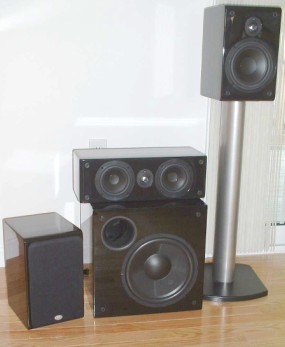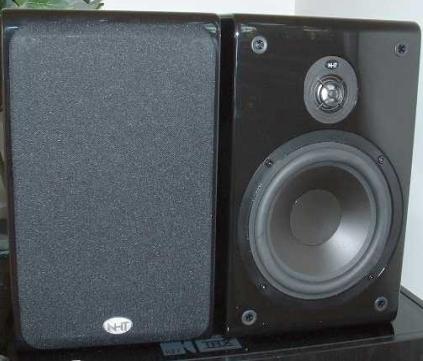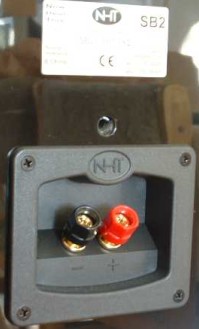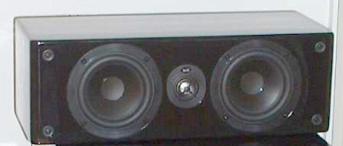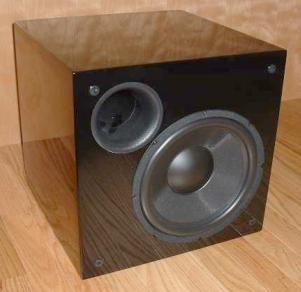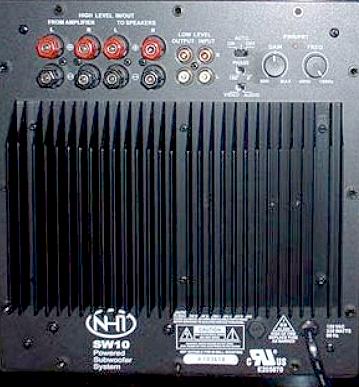|
|||||||||||||||||||||||
|
Introduction Recently, NHT overhauled its speaker lines and replaced its old product lineups with new ones. The speakers reviewed here are from the new SuperAudio series, which is the company's budget line. The system consists of the SB-2 bookshelf speakers ($400/pair), SC-1 center channel speaker ($300 each), and SW10 powered subwoofer ($500 each). Look, Feel, and Features The look of the new speakers departs a little bit from their predecessors. As opposed to sharp edges of the past design, the new speakers have rounded and smooth edges. Also, instead of laminate finish, NHT uses paint finish for the new enclosures. Such finish looks more elegant, but it is not as scratch resistant as the laminate finish. The review samples came in black piano lacquer finish, which in my opinion, looks very classy. For people who feel black is too offending to their room décor, NHT offers the SB-2 in white glossy finish. Strangely, NHT does not offer the SC-1 and SW10 in white. The craftsmanship of these speakers is excellent. Knocking on the speakers reveals that the cabinets are very well damped and solidly built. The SB-2 is the successor of the highly-acclaimed SuperOne. It has a 1" fluid-cooled metal dome tweeter and a single 6 1/2" polypropylene woofer in an acoustic suspension design. It is magnetically shielded, so you can safely place it very close to your television. The SB-2 offers more flexibility than its predecessor, the SuperOne, in that it is wall mountable. A screw hole is provided in the back for such purpose. The speaker terminals are five way binding posts, which accept bare wires, banana plugs, or spade plugs. The diameter of the posts is quite thick though, so some types of spade lugs may not fit properly. NHT also makes matching stands for the SB-2, called the Last Stand ($200/pair), which has an aluminum support column with black wood base and metal platform. If you like a contemporary look, you will enjoy having these stands with the SB-2s.
The SC-1 center channel speaker is sleek and relatively small. It uses the same type of tweeter as the SB-2 and has two 4 1/2" polypropylene woofers in an acoustic suspension design. As is the case with SB-2s, it is magnetically shielded. The rear of the SC-1 sports five way binding posts and an adjustable rod, which can be used to adjust the speaker orientation so that it points slightly down from on top of a TV. Rubber feet are also provided. Because of its relatively small size, the SC-1 can be easily put on top of most television sets.
The SW10 subwoofer is a front-ported design with a 10" polypropylene driver and a built-in 150 watt amplifier. All the usual subwoofer controls (volume, crossover frequency, polarity, on/off switch, and audio/video switch) are on the rear panel, and it has both line-level (RCA) and speaker-level inputs and outputs. High-pass filtered or full range options are available for both types of output. The SW10 can be switched on manually or automatically. I believe most users will leave it at auto-on for convenience, so that the subwoofer automatically turns on when it senses the presence of the incoming signal. An audio/video contour switch is also provided. According to the manual, when this switch is flipped to "Audio", the subwoofer produces flat bass response, which is ideal for music listening. When it is flipped to video, lower mid bass is enhanced, which may be desirable for movie sounds. However, in such setting the lower bass rolls off faster than in the audio setting, and the manual warns against the use of this setting when the main speakers are large and the crossover is set very low (below 40 Hz or so).
Performance and Sound For stereo performance evaluation, I put a pair of SB-2s on the Last Stands and slightly toed them in towards my listening position. I placed the speakers about 3 feet from the wall behind them with my distance to the speakers at about 1.5 times the distance between each other (NHT recommendation). Unless noted, the SW10 subwoofer was not used in this specific evaluation of the SB-2s. I broke in the speakers for about 50 hours before starting my critical listening. My first impression on the SB-2 sound was very clean and accurate. These speakers definitely leave very little room in those areas for the competition. Although relatively small, the SB-2s can play loud without strain. Soundstage and depth renditions are excellent. They can just disappear and transform us to the musical stage that is being played on them. The bass is tight and tuneful. For their size, the bass is actually quite strong. In fact, in small to medium size listening rooms, you probably won't feel the need for a subwoofer in most musical applications. And if you feel the need for additional bass, the SW10 subwoofer can complement the SB-2s nicely. I was able to achieve seamless transition between the SB-2 and SW10 in the low frequency range. As you can tell by now, I really like the SB-2s. No, they are not without weaknesses, but their weaknesses are far outweighed by their strengths. They don't have the last word in transparency and resolution, but this won't easily be noticed unless you have better speakers to compare to, which I did. Also, I found that even though the image produced by these speakers is good, it was not sharply focused. Please keep in mind though that my reference for the comparison was a $2500/pair-speaker. Considering that the SB-2s only cost $400/pair, then my comments above are really minor. Definitely, I consider the performance-to-cost ratio of the SB-2 to be very high. For home theater evaluation, two pairs of SB-2s, put on the Last Stands, were used for main and surround channels. The SC-1 center channel was put on top of my Sony Wega 32” television, and the SW10 subwoofer was placed on the front right corner of my listening room. I set the main, center, and surround speakers to small, and let my surround processor send all low frequency content (crossover at 80 Hz) to the subwoofer. I used the Avia audio section to balance the speakers and test the setup before playing DVD movies. The home theater performance of this speaker system is very admirable, especially considering its cost (MSRP $1,600). Front-to-back and side-to-side sound transitions are very nice and smooth. When set up correctly, the system off-axis response is quite satisfactory. Except for the slight surround imbalance when sitting off-axis, I did not notice dialog or front-effects degradation. Despite its small size, the SC-1 was capable of delivering good dialog intelligibility. Its vertical dispersion, however, is rather narrow. So to achieve the best result, it should be aimed at the ear level of the listener. If it is aimed too high or too low from the ear level, the resulting dialog intelligibility might suffer. The adjustable bar on the back of the SC-1 comes in handy to help in orienting the SC-1 properly.
I also like the SW10 subwoofer. It is capable of providing the necessary low
frequency impact and rumble when it is called for. In my relatively large
room (about 15 ft by 20 ft), the SW10 was able to produce useful bass
response down to about 30 Hz in the audio contour setting. Depending on your
taste, you can also enhance the bass impact by using the video contour
switch. However, personally, I prefer to use the audio contour setting in
all applications. The video setting sounds a little too boomy for my taste.
NHT has built its legacy on high performance products without premium price.
After listening extensively to this budget NHT speaker package, I can
happily say that this legacy continues. The SB-2 speakers are an excellent
multi-function performer. They nicely define high-end on a budget. The
overall performance of the SB-2, SC-1, and SW10 speaker package leaves
little to be desired, on that budget. You won't be disappointed!
|
|||||||||||||||||||||||

